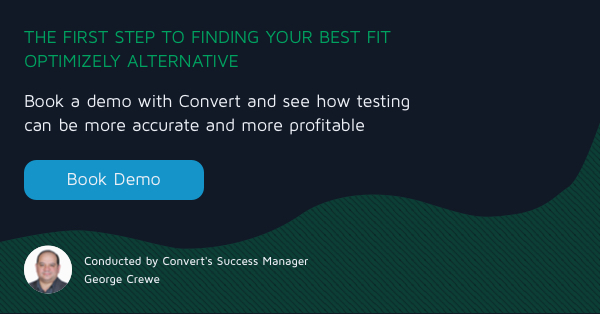Optimizely’s pricing is changing (again). Let’s talk options

First: let’s address the big, ugly elephant in the room.
Yes, this is an article about choosing A/B testing software—from some folks who just happen to make A/B testing software.
I get it.
I wouldn’t trust me either.
But on the daily, we’ve been getting feedback like this:
“Optimizely is phasing us out of their legacy plans—and we feel like we’re back to the drawing board.”
So we felt it only right, as folks who are paid to know the landscape better than anyone—to give some as-impartial-as-absolutely-possible-we-swear advice.
(Including reasons that our competitors might be a better choice for your company).
So here’s the lowdown on what’s changing with Optimizely…and where, depending on the needs of your business, you should go from here.
How Optimizely’s Pricing is Changing
Put simply:
- Farewell, free plans.
- Optimizely Legacy Plans (aka, Optimizely Classic’s Starter, Bronze, Silver, Gold and Platinum Plans) are getting phased out—and customers are being pushed to Optimizely X’s enterprise options.
- All plans are priced and paid yearly.
What will that enterprise option cost? Well that depends. On your business, on your traffic.
In the past, we’ve gotten estimates between $2,500-$3,000 USD per month, if you have between 300,000-400,000 unique visitors.
Recently, though, we’ve been told plans start at a minimum of $36,000 a year, for 200,000 visitors or more.
And we consistently hear quotes like this:

And here’s what some folks from elsewhere on the internet have to report:

It’s all a little murky, but what seems to be clear is: EVEN if you were on Optimizely Platinum in the past—you’re looking at a solid price hike as you’re pushed to transition.
So what now?
Stick with Optimizely, at enterprise pricing, if…
Skip this section if you know it’s out of your budget.
But there’s really no doubt about it: Optimizely is an incredible tool. The interface is smooth and easy to work with. And when it comes to features, it has some of your other platforms beat.
(We’ve mapped a full chart of A/B testing tools by their features here).
Some of Optimizely X highlights are…
- They offer the most robust full stack testing system.
- They run their testing server side.
- They equip you with a dedicated Account Manager.
- Their user profiles and personalization options are exceptionally nuanced.
Conversion rate optimization is an investment—no doubt about it.
So…if you need personalizations based on external audiences.
If you rely on powerful analytics for those truly in-depth audience insights.
If you offer an experience unified across Over-the-Top devices (OTT), web and mobile….
Right now, Optimizely is your only option.
So if you regularly sell clients, or see huge site improvements, from a full stack test, or because of the mobile OTT—maybe you’ll want to look into taking the Optimizely X leap.
Otherwise: read on.
Switch to Google Optimize, if…
Google Optimize is a solid tool—great for people who have: no budget, or a huge budget.
If you were previously using the free version of Optimizely, you’ll be thrilled to hear about Google Optimize’s free option.
It’s the kind of A/B testing tool you would expect Google to put out—solid, and user-friendly.
The limits you’ll run into here:
- Recently, Google Optimize upped it’s max concurrent experiments limit from 3 to 5. Still—if you’re an agency, or are regularly running multiple tests, this might be a roadblock.
- You can run multivariate experiments, as long as you’re making less than 16 changes across the page. Every element counts as a change here—so if you’re editing (for some bizarre reason), all your H4s, or all your buttons—you might run up against that limit.
- You’ll have a hard time integrating third parties with Google Optimize. So if you use heat mapping technology, or want easy integration with Shopify, or count on other tools playing nice with your testing platform—this might not be your best choice.
- If you’re going beyond the visual editor, there are limits to your code. Scripts are limited to 10240 characters.
- Full-funnel / Multi-page experiments aren’t available.
(You can see the full feature breakdown or Google Optimize vs Optimizely here).
Now on the flipside, if you upgrade to their enterprise options—Google Optimize 360—you can do all sorts of really innovative things. Some of its coolest features have to do with its native integration with Google Analytics.
You can use your Analytics user segments, to identify key segments within Optimize. And you can retroactively compare your Optimize results against your Analytics goals.
It’s a pretty powerful way to evaluate and segment.
But it comes at a price.
Some estimates for Google Optimize 360 come at over $150,000 a year.
So if your goal is to make the transition from Optimizely to something more affordable—this might not be your best bet.
Switch to Visual Web Optimizer if…
If you’re still at this in-between point—where you can’t justify shelling out Optimizely X’s six figure pricing, but need something a little robust than your Google Optimize basics—you have a few more choices.
A few things that are pretty dang cool about VWO:
- If you use heatmaps, surveys, or personal session recordings—VWO has ‘em. No need to integrate with other software.
- VWO prides itself on allowing you to really drill down, and understand an individual user, as they travel through your funnel. Though their analytics capacities are still a little sparser than Optimizely, the data you’ll get is really very robust.
- If you have 100k of traffic or less: they have a really affordable plan that might be right up your ally. It gives you up to 5 active collaborators, and unlimited active domains—plus packs a lot of the same features as their enterprise options.
(We also have a full breakdown of VWO’s features, and plan types, here).
Some limits:
- They cap you on projects and clients—until you get to their enterprise plan.
- JS targeting, custom tag targeting, geo / demographic targeting—also aren’t available at their lower traffic capped plans.
- If you do use Google Analytics to complement what you can learn from your testing—you won’t be able to import goals, or revenue track, with VWO.
- Your support options are also a little limited with VWO. Their enterprise plans have phone support available; but for anything shy of that, you’re limited to email tickets.
In general: if you’re creative with your tests—and really drill deep into your test results—VWO is a solid choice. But if you’re worried about running into testing caps, or getting quick-access to support if something seems “off”—you might want to look elsewhere.
Switch to Convert if…
It took us a while, in this busy CRO-tool landscape, to get good at what we do, and recognize what we have to offer.
But here’s where we are.
Look into us as an option if…
You understand the value of flicker-free testing—and don’t want your A/B test load times to skew your results. At Convert, we learned how your load speeds affect your conversion rate, and we got more-than-a-little obsessive about reducing that bounce-inspiring flicker. We did everything we could to kill the blink—and, recently ConversionXL ranked us amongst the best for site performance.
You want to talk to a human when you have an issue—and having live chat support might make your day-to-day a bit easier. Waiting with a ticket number, or sitting on an hour long hold, is infuriating—especially when you have client deadlines, or metrics to meet.
We don’t want people to be infuriated. So we offer live chat. And in general—we’ve really committed ourselves to support. Right now, our G2Crowd reviews rank our “ease of doing business with” at 100%.
You care about sustainable infrastructure, and you’d like your dollars to go to a conscious business. We use carbon neutral hosting. We invest in our nonprofit partners. We’re working towards a 1:1 male/female hiring ratio. We do a bunch of other do-gooder-y things. You can read about them here.
Data privacy, security, and transparency are important to you. Here’s a quick look at how Optimizely deals with privacy. With GDPR changing the data-processing game come May 2018—this has become particularly important to us.
If you’re in the EU, or you process web traffic from EU citizens—the new GDPR legislation is going to affect you. We’ve kept our software simple—your analytics come from aggregate data, rather unique I cookies. This just one reason that, in the default setting, you won’t have to ask for consent to run tests with Convert. We’ve also committed to support Do Not Track.
Some limits:
- We’ll admit it. We’ve built out a mountain of integrations—but Convert lacks some of the features (heat-mapping, hyper-granular personalizations) that you’ll find with our competitors.
- Intentionally, we’ve kept our analytics platform a bit more basic. We don’t drill down our reports to user behavior the way Optimizely or VWO do.
- We don’t offer machine learning, or behavioral analytics.
Analyze all Optimizely alternatives for features, support & pricing.
Based in the EU? Testing Traffic from the EU? One more thing to consider…
One thing that we want to stress, especially if you’re considering making changes to your current A/B testing set up…
The EU’s General Data Protection Regulation comes into force on May 25th. And it has big ramifications for how we process cookies, and segment with unique identifiers. Meaning: it has big ramifications for the legality of A/B testing.
The short version is, under GDPR, you need to either have “legitimate interests” backing for data collection, or you have to ask for explicit, affirmative consent. If your software is too invasive to justify the former, the latter has the potential to cut down your testable traffic considerably.
We’ve outlined everything you need to know, and detailed the questions you should be asking your A/B testing software vendors, here.
To sum it up:
- Optimizely is changing for the pricier.
- If you can afford it, and rely on full-stack testing, or ahead-of-the-game analytics: stick with ’em.
- If you can’t—if you just do some basic testing here and there, and need some software that’ll get the job done—think about Google Optimize’s free plan.
- If you do a little more than that, but a little less than “six figures on software” worth—and you want a lot of the extra bells and whistles that help you zoom in on a particular user—check out VWO.
- If you just want software that works well, and to test a team that’ll work with you—give us a try at Convert. We have a free trial (no credit card required).

